#Actinistia
Text
Uncharismatic Fact of the Day
Coelacanths are often thought of as a species untouched by time, due to their ancient evolutionary lineage and long lifespans. These fish evolve slow, move slowly, grow slowly, and even give birth slowly; pregnancies can last anywhere from three to five years, after which she gives birth to up to 25 live pups.
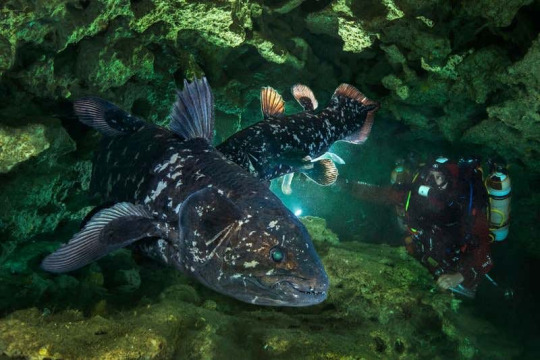
(Image: A pair of West Indian Ocean coelacanth (Latimeria chalumnae) (left) by Laurent Ballesta)
If you like what I do, consider leaving a tip or buying me a kofi!
218 notes
·
View notes
Text

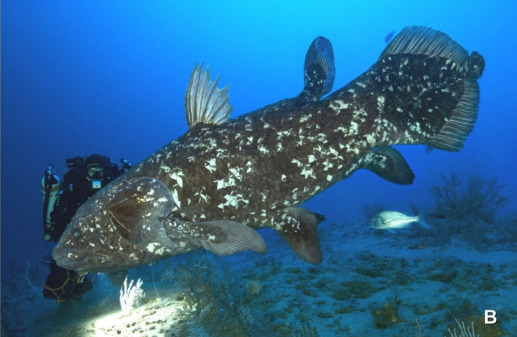
Happy Fossil Friday!
Who: Coelacanthiformes
What: Coelacanths! Large lobe-finned fish from the Class Actinistia, a close relative of the lungfish.
When (group): Devonian - Present (thought to have gone extinct during the End-Cretaceous extinction event, but members of the group were "rediscovered" in 1938)
Where: (Living representatives) along the east African coast and the Comoros Archipelago in the Indian Ocean.
(Fossil representatives) England, Czech Republic, France, Germany, India, Switzerland, Brazil, Democratic Republic of the Congo, China, Uruguay, USA, and more.
Fun Fact!: There are two living speices (that we know of) of Coelacanth: Latimeria chalumnae & Latimeria menadoensis
Here is a link to an article for the story of how this "living-fossil" was rediscovered by the scientific community and the museum curator who's quick thinking and determination helped bring this animal back into the spotlight.
Why are they cool?: Instead of the bony vertebral column shared by other vertebrates the coelacanth retains the ancestral fluid filled notochord which is less rigid than vertebrae, but offers more flexibility.
Image Credits: (Left) Coelacantheformes Fossil From the Natural History Museum of Bamberg & (Right) Laurent Ballesta - Gombessa Expéditions
159 notes
·
View notes
Note
the coelacanth, previously thought to be extinct, is an ancient and critically endangered species of fish belonging to the sarcopterygii (lobe-finned fish) clade in the class Actinistia.
currently, the eastern african coast is the primary range for these creatures, particularly in kenya, tanzania, mozambique, south africa, madagascar, and comoros, although some coelacanths have been spotted in other places like indonesia.
they are also trans allies :)

HUZZAH THEYRE ALLIES
(no but I feel rlly stupid now 😭)
6 notes
·
View notes
Note
The coelacanths (/ˈsiːləkænθ/ (listen) SEE-lə-kanth) are fish belonging to the order Actinistia that includes two extant species in the genus Latimeria: the West Indian Ocean coelacanth (Latimeria chalumnae), primarily found near the Comoro Islands off the east coast of Africa, and the Indonesian coelacanth (Latimeria menadoensis).[2] The name "coelacanth" originates from the Permian genus Coelacanthus, which was the first scientifically named coelacanth.[3]
Coelacanths follow the oldest-known living lineage of Sarcopterygii (lobe-finned fish and tetrapods), which means they are more closely related to lungfish and tetrapods (which includes amphibians, reptiles, birds and mammals) than to ray-finned fish. They are found along the coastline of Indonesia and in the Indian Ocean.[4][5] The West Indian Ocean coelacanth is a critically endangered species.
The oldest known coelacanth fossils are over 410 million years old. Coelacanths were thought to have become extinct in the Late Cretaceous, around 66 million years ago, but were discovered living off the coast of South Africa in 1938.[6][page needed][7]
The coelacanth was long considered a "living fossil" because scientists thought it was the sole remaining member of a taxon otherwise known only from fossils, with no close relations alive,[8] and that it evolved into roughly its current form approximately 400 million years ago.[1] However, several more recent studies have shown that coelacanth body shapes are much more diverse than previously thought.[9][10][11]
Literally that's what im sayign
2 notes
·
View notes
Photo

West Indian Ocean coelacanth (Latimeria chalumnae)
Photo by Arne Kuilman
#west indian ocean coelacanth#gombessa#latimeria chalumnae#latimeria#latimeriidae#coelacanthiformes#actinistia#vertebrata#chordata
576 notes
·
View notes
Photo

Coelacanths are represented today by just two surviving species, one in East Africa and one in Indonesia, both very similar in appearance and ecology to each other.
For a long time their lineage was thought to be all "living fossils", retaining the same basic body plan for the last 400 million years – but more recent discoveries have revealed that these fish were actually much more diverse over the course of their evolutionary history.
Holopterygius nudus was a fairly early member of the group, living during the mid-Devonian about 385 million years ago. The only known fossil specimen was discovered in Germany in the 1970s, but it was originally thought to be a different type of fish entirely and wasn't identified as being a coelacanth until over 30 years later.
And compared to its living relatives it was tiny, just 7cm long (2.75"), with a distinctive tapering eel-like tail. Its convergent close resemblance to modern cusk-eels suggest it may have occupied a similar ecological niche, living near the sea floor and hiding in tight spaces like crevices and burrows.
———
Nix Illustration | Tumblr | Pillowfort | Twitter | Patreon
#science illustration#paleontology#paleoart#palaeoblr#holopterygius#coelacanthiformes#coelacanth#actinistia#sarcopterygii#lobe-finned fish#fish#art#eelacanth
172 notes
·
View notes
Text
Foreyia maxkuhni

Etymology: Forey’s Fish
First Described By: Cavin et al., 2017
Classification: Biota, Archaea, Proteoarchaeota, Asgardarchaeota, Eukaryota, Neokaryota, Scotokaryota, Opimoda, Podiata, Amorphea, Obazoa, Opisthokonta, Holozoa, Filozoa, Choanozoa, Animalia, Eumetazoa, Parahoxozoa, Bilateria, Nephrozoa, Deuterostomia, Chordata, Olfactores, Vertebrata, Craniata, Gnathostomata, Eugnathostomata, Osteichthyes, Sarcopterygii, Actinistia, Coelacanthiformes, Latimerioidei, Latimeriidae,
Time and Place: Foreyia lived about 240.91 million years ago, in the Ladinian of the Middle Triassic
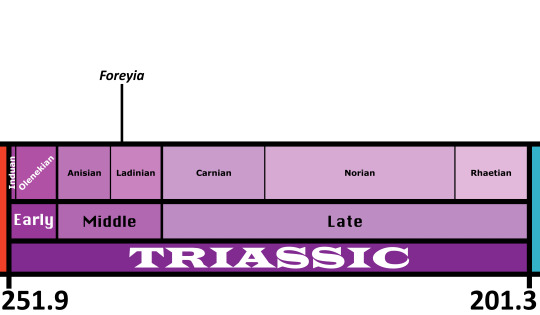
Foreyia is known from the Prosanto Formation of Switzerland

Physical Description: Foreyia was a Coelacanth, a sort of Lobe-Finned Fish once thought to be a unique feature of prehistoric ecologies, and now known to survive in two different species today. This is wild, of course, but Coelacanths were weird in many different ways throughout their prehistoric tenure. Foreyia looked only a little similar to its cousins - it had a huge head compared to other Coelacanths, as well as a beak - something that you really only see in ray-finned fish and tetrapods - an underbite, and a horn on its head. That said, its body looks similar enough to other coelacanths, with dorsal fins and a wide tail fin, and large forelimb fins. However, the large size of its head makes it look like a Coelacanth that had been squished extensively, with the body looking quite short and squished compared to its close relative Ticinepomis. We aren’t sure as to what colors it may have been, but since it lived in a tropical region and may have had a similar niche as a Parrotfish, it is reasonable to suppose it may have been colorful. It was also very small, only around 20 centimeters long.
Diet: Given the beak, it’s likely that Foreyia ate hard food, potentially even similarly to living parrotfish - by chipping off algae covered rocks and reef builders, or potentially eating small shelled animals in the tidal pools.
Behavior: Foreyia’s head was huge, and so that likely impacted its swimming style, though it is unclear how. Modern Coelacanths moving very slowly through the water, moving their fins to help propel through. Since Foreyia reduced the size of its fins to an extent, it’s possible that the tail (which was very large compared to the rest of the body) was more vital in swimming, and the head may have been used to help steer (though this is just a hypothesis). The bony shield may have also been helpful in protecting Foreyia from danger, which makes sense ans many predators were present in its environment. This is at least somewhat supported by its strong clavicle muscles. It probably would have spent a significant amount of time grazing, either on small crunchy invertebrates or algae. Today, Coelacanths don’t seem to shoal much; however, that may not have been the case in the past, so we can’t infer a loner lifestyle for Foreyia.
Ecosystem: Foreyia lived in a coastal shelf environment, specifically in a tidal basin that would often become anoxic as the tide went out during the day, meaning that Foreyia had to move around a lot to avoid suffocation. This environment was probably at least somewhat reef or tidal pool like, with a variety of fish swimming around in the ecosystem. There were many ray-finned fish here, including Peltopleurus, Habrichthys, Archaeosemionotus, Saurichthys, Ctenognathichthys, Besania, Prosanticthys, Eoeugnathus, and Ducanicthys. There was also another Coelacanth, Ticinepornis. As for tetrapods, there was the Pachypleurosaur Neusticosaurus, the Helveticosaurid Eusaurosphargis, and the Tanystropheid Macrocnemus. These reptiles would have been major predators of Foreyia.
Other: Foreyia is so weird in its shape that the original authors proposed it was Heterochronic - ie, different aspects of baby Coelacanth anatomy were retained in order to provide useful adaptations for Foreyia. However, some later researchers have cast doubts on this idea, given that baby Coelacanths don’t… actually seem to resemble Foreyia. Clearly, the jury is still out!
~ By Meig Dickson
Sources Under the Cut
Arratia, G., and A. Herzog. 2007. A New Halecomorph Fish from the Middle Triassic of Switzerland and its Systematic Implications. Journal of Vertebrate Paleontology 27(4):838-849.
Bürgin, T., U. Eichenberger, H. Furrer and K. Tschanz. 1991. Die Prosanto Formation - eine fischreiche Fossil-Lagerstätte in der Mitteltrias der Silvretta-Decke (Kanton Graubünden, Schweiz). Eclogae Geologicae Helvetiae 84:921-990.
Bürgin, T., and A. Herzog. 2002. Die Gattung Ctenognathichthys (Actinopterygii, Perleidformes) aus der Prosanto-Formation (Ladin, Mitteltrias) Graubündens (Schweiz), mit der Beschreibung einer neuen Art, C. hattichi sp. nov. Eclogae Geologicae Helvetiae 95:461-469.
Carroll, R. L., and P. Gaskill. 1985. The nothosaur Pachypleurosaurus and the origin of plesiosaurs. Philosophical Transactions of the Royal Society B 309:343-393.
Cavin, L., H. Furrer, and C. Obrist. 2013. New coelacanth material from the Middle Triassic of eastern Switzerland, and comments on the taxic diversity of actinistans. Swiss Journal of Geosciences 106:161-177.
Cavin, L., B. Mennecart, C. Obrist, L. Costeur, and H. Furrer. 2017. Heterochronic evolution explains novel body shape in a Triassic coelacanth from Switzerland. Scientific Reports 7(13695):1-7.
Ferrante, C., L. Cavin, H. Furrer, R. Martini. 2018. Coelacanths from the Middle Triassic of Switzerland show unusual morphology. Swiss Geoscience Meeting.
Fraser, N., and H. Furrer. 2013. A new species of Macrocnemus from the Middle Triassic of the eastern Swiss Alps. Swiss Journal of Geoscience 106:199-206.
Herzog, A. 2001. Peltoperleidus obristi sp. nov., ein neuer, kleiner Strahlenflosser (Actinopterygii, Perleidiformes) aus der Prosanto-Formation (Mitteltrias) von Graubünden (Schweiz). Eclogae Geologicae Helvetiae 94:495-507.
Herzog, A. 2003. Eine Neubeschreibung der Gattung Eoeugnathus Brough, 1939 (Actinopterygii; Halecomorphi) aus der alpinen Mitteltrais Graubündes (Schweiz). Palaeontologische Zeitschrift 77(1):223-240.
Herzog, A., and T. Bürgin. 2005. A new species of the genus Besania Brough 1939 from the Middle Triassic of Canton Grisons (Switzerland) with a discussion of the phylogenetic status of the taxon. Eclogae Geologicae Helvetiae 98:113-122.
McMenamin, M.A. S. 2018. Coelacanth Vestiges. Deep Time Analysis, Springer Publishing.
Scheyer, T. M., J. M. Neenan, T. Bodogan, H. Furrer, C. Obrist and M. Plamodon. 2017. A new, exceptionally preserved juvenile specimen of Eusaurosphargis dalsassoi (Diapsida) and implications for Mesozoic marine diapsid phylogeny. Scientific Reports 7:4406.
#foreyia#foreyia maxkuhni#coelacanth#Triass March Madness#triassic madness#triassic#prehistoric life#paleontology
294 notes
·
View notes
Text
Divisions of Vertebrates
Myxini
-- hagfish
Petromyzontida
-- lampreys
Chondrichthyes
-- sharks
-- rays
-- chimaeras
Actinopterygii
-- ray-finned fishes
Actinistia
-- coelacanths
Dipnoi
-- lungfishes
Tetrapoda
-- amphibians
-- reptiles
-- mammals
Patreon | Ko-fi
#studyblr#notes#biology#biology notes#bio#bio notes#vertebrates#divisions of vertebrates#vertebrata#taxonomy#classification#biological classification#taxonomy notes#classification notes#biological classification notes#vertebrata notes#marine science#marine biology#science#scienceblr
3 notes
·
View notes
Photo

Eastern Thalassian Oceanic Fauna
Saber Monkey (#1)
Kingdom: Animalia
Phylum: Chordata
Class: Mammalia
Order: Primates
Suborder: Haplorhini
Infraorder: Simiiformes
Family: Cercopithecidae
Tribe: Papionini
Genus: Smilopithecus
Species: S. piscophagus (”fish-eating knife ape”)
Ancestral species: Macaca radiata (Bonnet macaque)
Time period: late Nyctocene to early Solocene (102 million years to 118 million years in the future).
Information: a massive, piscivorous monkey the size of a lion, the Saber Monkey lives across the eastern coast of Thalassia, where it hunts in the shallow seas and estuaries. It uses its long teeth to help grip onto prey, and its hands and feet are webbed to help aid in swimming. Its thick, brown, fur coat is hydrophobic, meaning that water will not adhere to its surface, and it also doubles as protection against the cold. As of so far, we are uncertain of the threat it possesses to humans. Therefore, if approaching this animal, one should take reasonable caution.
Dragonfish (#2)
Kingdom: Animalia
Phylum: Chordata
Class: Actinopterygii
Order: Siluriformes
Family: Dracoichthyidae
Genus: Dracoichthyes
Species: D. siluroides (”silurus [a genus of catfish]-like dragon fish”)
Ancestral species: Bagarius yarrelli (Goonch)
Time period: early Solocene (105 million years to 120 million years in the future).
Information: a fast-moving oceanic catfish the size of a Great Barracuda, the Dragonfish bares a vague resemblance to the dragons of East Asian folklore. It hunts primarily in open oceans worldwide, and feeds upon primarily other fish. Its skin is dark blue on its back and light blue on its underside to provide camouflage. Armed with a vicious set of sharp teeth, the Dragonfish’s jaws is not something that you’d want to find yourself on the receiving end of. Its large eyes help it to see in the dark.
Vent Worm (#3)
Kingdom: Animalia
Phylum: Annelida
Class: Polychaeta
Subclass: Aciculata
Order: Xenopodia
Family: Deinoannelidae
Genus: Deinoannelida
Species: D. giganteus (”giant terrible annelid”)
Ancestral species: Alitta virens (Sandworm)
Time period: early to late Solocene (105 million years to 140 million years in the future).
Information: with its chimerical appearance, one would guess upon first glance that the Vent Worm were a creature from another planet. But in fact, it is just as much an earthen being as us. The Vent Worm, despite its name, does not live solely in volcanic vents. In fact, it can be found almost anywhere in the ocean worldwide, from warm, shallow seas to cold, deep trenches. Its name derives from the fact that it was first discovered near volcanic vents. The Vent Worm is a very-large annelid, being nearly 6 feet in length. It predates on a variety of different creatures, including fish and even occasionally stripping pieces of flesh off of live animals. Its skin is a sandy color with its crest and break are grey.
Estuarine Coelacanth (#4)
Kingdom: Animalia
Phylum: Chordata
Class: Sarcopterygii
Subclass: Actinistia
Order: Coelacanthiformes
Family: Microcoelacanthidae
Genus: Microcoelacanthus
Species: M. orientalis (”eastern small hollow spine”)
Ancestral species: Latimeria menadoensis (Indonesian coelacanth)
Time period: late Lithocene to early Solocene (65 million years to 110 million years in the future).
Information: at only around a foot in length, the Estuarine Coelacanth is a fairly-small creature. Its scales a light blue color, allowing it to blend in with the surrounding water. It feeds primarily off of aquatic plants, but will also eat worms it can find in the sediment. Though it is low on the food chain, a special chemical in its flesh prevents most predators from wanting to eat it, as its flesh tastes notoriously-bad. It is found across much of Thalassia’s coast.
Cormorant Turtle (#5)
Kingdom: Animalia
Phylum: Chordata
Class: Reptilia
Clade: Testudinata
Order: Testudines
Suborder: Cryptodira
Family: Ornithochelidae
Genus: Ornithochelys
Species: O. coelosteus (”hollow-boned bird-turtle”)
Ancestral species: Macrochelys temminckii (Alligator snapping turtle)
Time period: early Solocene (105 million years to 115 million years in the future).
Information: a massive turtle the size of a bottlenose dolphin, the Cormorant Turtle is a semiaquatic hunter found along the coast of eastern Thalassia and western Occidensia. It feeds primarily of fish, and is notable amongst turtles for the fact that its shells is now vestigial, taking the form of armor plating on its back and underside. Their skin is green to blend in in the kelp forests where they predominantly hunt. Its aerodynamic body allows it to travel at fast speeds, and its clawed hind legs are for helping it move on land.
Bat Seal (#6)
Kingdom: Animalia
Phylum: Chordata
Class: Mammalia
Order: Carnivora
Suborder: Caniformia
Infraorder: Arctoidea
Clade: Pinnipedia
Superfamily: Otarioidea
Family: Aeropinnipedidae
Genus: Aeropinnepedia
Species: A. chiropterygoides (”bat-like air seal”)
Ancestral species: Neophoca cinerea (Australian sea lion)
Time period: early to late Solocene (105 million years to 140 million years in the future).
Information: the Bat-Seal is a very-interesting case of convergent evolution. As its name would suggest, though it morphologically looks like a bat, it is, in fact, a seal that has evolved to live a life in the air, even going so far as to re-evolve hind legs with digits. The Bat-Seal is comparable in size of a wolf, and is a cathemeral piscivore, predating on a wide variety of fish. Its brown fur is hydrophobic, hence allowing it to dive into the water if necessary. Its eyesight is exceptional, and it is particularly attracted to shiny objects, which it perceives as its prey. Its threat level to humans seems to be low, and they show a kind-of friendly curiosity around people. They live along several coastal regions worldwide.
Sea Parrot (#7)
Kingdom: Animalia
Phylum: Chordata
Superclass: Osteichthyes
Class: Actinopterygii
Order: Perciformes
Suborder: Labroidei
Family: Labridae
Genus: Psittacoichthyes
Species: P. fatalis (”deadly parrotfish”)
Ancestral species: Chlorurus sordidus (Daisy parrotfish)
Time period: early Solocene (105 million years to 115 million years in the future).
Information: the Sea-Parrot is peculiar for a parrotfish in that it is actually a carnivore. An ornately-colored carnivore. At around the size of a small dog, the Sea-Parrot is a formidable predator of smaller fish, in particular the Estuarine Coelacanth. It lives across many tropical and subtropical oceans of the world, and can occasionally be found wandering into more-temperate waters, where its bright green and blue scales make it stand out a lot from the local oceanic fauna. Its threat level is low to humans, and they, in fact, seem very-skittish around humans.
Whale Monkey (#8)
Kingdom: Animalia
Phylum: Chordata
Class: Mammalia
Order: Primates
Suborder: Haplorhini
Infraorder: Simiiformes
Family: Hydropithecidae
Genus: Hydropithecus
Species: H. cetops (”whale-faced water ape”)
Ancestral species: Papio anubis (Olive baboon)
Time period: early Solocene (105 million years to 120 million years in the future).
Information: bearing a vague resemblance to the Ambulocetus of an era long past, the Whale Monkey is a lion-sized semiaquatic hunter found across much of Thalassia’s coast. It is a crafty and intelligent primate, and can make tools, though it rarely needs them. The Whale Monkey is an omnivore, and feeds off of a variety of plant matter and animals. They are social animals, and tend to live in small troops of around 10 other individuals. Their fur is brown and hydrophobic. Like primates from our own timeline, they are very playful and inquisitive towards humans, and will actively approach them. This may perhaps one of the most-bizarre creatures we’ve encountered so far...
Emperor Seal (#9)
Kingdom: Animalia
Phylum: Chordata
Class: Mammalia
Order: Carnivora
Suborder: Caniformia
Infraorder: Arctoidea
Clade: Pinnipedia
Family: Phocidae
Genus: Suchocetus
Species: S. imperator (”emperor crocodile-whale”)
Ancestral species: Phoca vitulina (Harbor seal)
Time period: early to late Solocene (105 million years to 140 million years in the future).
Information: At 20 feet in length and fully aquatic, the Emperor Seal bears a vague resemblance to pliosaurs. Likewise, it fills a similar ecological role. Stalking the seas around Thalassia, the Emperor Seal hunts a variety of other animals, both big and small. Its fur is brown with grey spots, and concealed in its jaws are a large set of canines, which allow it to grip onto its prey and tear it apart. But even this massive animal has predators. It is predated upon by both the Great Sea-Reaper and the Giant Eel Shark alike, and therefore, its smaller size compared to both make it vulnerable. Luckily, it can also use this to its advantage, as this allows it to retreat to the shallows if necessary.
Coral Shark (#10)
Kingdom: Animalia
Phylum: Chordata
Class: Chondrichthyes
Subclass: Elasmobranchii
Infraclass: Euselachii
Superorder: Selachimorpha
Order: Squaliformes
Family: Squalidae
Genus: Microcarcharus
Species: M. orientalis (”eastern small shark”)
Ancestral species: Squalus acanthias (Spiny dogfish)
Time period: early to mid Solocene (105 million years to 125 million years in the future)
Information: the Coral Shark, at only 2 feet long, is a fairly-small animal. Feeding on a variety of smaller fish, particularly Kittenfish, the Coral Shark lives primarily in tropical reefs worldwide, hence its name, but can be found in subtropical and even temperate regions. Its skin is a greyish-white color, and it is a fairly-skittish animal.
Reef Dagger (#11)
Kingdom: Animalia
Phylum: Chordata
Class: Actinopterygii
Order: Scombriformes
Family: Xenoscombridae
Genus: Pseudoanguilla
Species: P. ferox (”fierce false eel”)
Ancestral species: Ruvettus pretiosus (Oilfish)
Time period: early Solocene (105 million years to 117 million years in the future).
Information: at around 3 feet in length with 4-inch-long tusk-like teeth, the Reef Dagger is a force to be reckoned with. Living along much of Thalassia coast, this mottled green-and-brown predator hunts by ambushing, waiting silently on algae-covered rocks for smaller to approach before jolting up and engulfing them in its maw. It is a fairly slow-swimming animal, and hence uses its fins to “walk” on the seafloor. Certainly not something you want to accidentally step on...
Reef Shark (#12)
Kingdom: Animalia
Phylum: Chordata
Class: Chondrichthyes
Subclass: Elasmobranchii
Infraclass: Euselachii
Superorder: Selachimorpha
Order: Heterodontiformes
Family: Sinocarcharidae
Genus: Sinocarcharus
Species: S. macrops (”large-eyed Chinese shark”)
Ancestral species: Heterodontus portusjacksoni (Port Jackson shark)
Time period: early to late Solocene (105 million years to 140 million years in the future).
Information: the Reef Shark is fairly-small, being only about 4 feet long. It lives along the coasts of eastern Thalassia and feeds predominantly on smaller fish. its skin is brown with black spots on its back.It is primarily nocturnal, hence its large eyes. They are skittish animals, being easily scared off by larger animals.
0 notes
Text
i was tagged by @ocean-bisexual
Rules: Answer the 20 questions and tag 20 amazing people you would like to get to know better.
Name: Allison
Nicknames: Well, I mostly go by Allie, but my boyfriend and my parents sometimes call me Al.
Zodiac Sign: Sagittarius. Rising: Virgo, Moon: Scorpio
Height: 5′4′’ (and a half!!)
Orientation: bisexual, but questioning. I think I might be a lesbian but that’s a little funky to figure out when you’re dating a man...
Ethnicity: white
Favorite Fruit: mango wins out, but I love raspberries and kiwis too.
Favorite Season: Well in my moody high school days I always said Autumn, but now that I realize I can be a wannabe goth and love the Spring I can finally admit that’s my favorite (though fall fashion kicks ass)
Favorite Book Series: Well, I don’t read many series, but I guess I’ll just fall back to Eragon, one of the only series I’ve finished.
Favorite Flower: is it too cliche to say red roses?
Favorite Scent: I really like the way the air smells after a Summer rain.
Favorite Color: I honestly have more of a favorite color palette than single color. My palette is: deep red, black, gray, white, dark teal, and baby pink
Coffee, Tea, or Cocoa: cocoa mostly, but I drink some tea. Can’t stand coffee though.
Average Sleep Hours: idk I probably average what sounds like a good number, like 7 or 8, but it’s based on a duel-peaked distribution at either end. I sometimes sleep 10 hours, sometimes 4. There isn’t much in between, especially in the Summer.
Cat or Dog Person: Dogs for sure. I grew up with two of the best little babies in the world. I lost them both in the past couple of years, but they visit me in my dreams a lot. I don’t dislike cats though, but my minor allergy to them messes things up a bit.
Favorite Fictional Characters: Well, despite Joss Whedon being a shit, Buffy will always have a special place in my heart. I also really love Liv from iZombie, and Amy from Gone Girl.
Dream Trip: a A long trip across Europe, visiting major cities and historical sites, staying in scenic bed and breakfasts, and going to all kinds of beaches.
Blog Created: this Well my friends convinced me to make this my sophomore year of college because my main site at the time (Imgur) was just making me a miserable person because the userbase was so unreceptive to progressive ideas. So it’s been about 3 years and some change now.
Number of Followers: 123 (I’m an avid spam blog+porn blog blocker haha)
I don’t have a ton of people to tag, so I’ll just tag some of my couple of mutuals and some others
@actinistia @tiocfaidharlulz @a-secret-vice @intentnevermakesasound @fakecel @lil-queen-trashmouth @tofu-kiddo @peachgreenteelemonade @vivasophiaaa @kitabuni @love-pro-choice @gibbousqueen @freezepeaches
hey I actually got closer than I thought I would.
#if you feel weird being tagged no pressure to respond#alternatively if you weren't tagged I probably assumed you wouldn't want to answer#gosh I'm making this awkward#thanks for tagging me though!!
4 notes
·
View notes
Photo
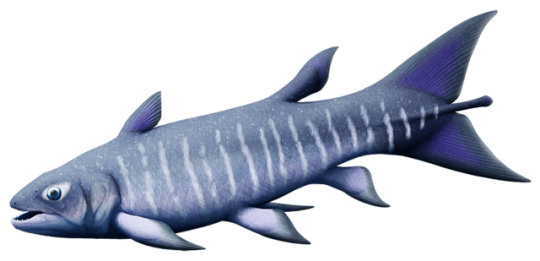
Coelacanths are famous for being “living fossils”, completely disappearing from the fossil record at the end of the Cretaceous but then being rediscovered alive just 80 years ago. But although they’re often thought to have physically changed very little over the last 300 million years or so, more recent discoveries are starting to show that coelacanth body forms and lifestyles were actually more varied in the distant past.
Meet the wonderfully-named Rebellatrix divaricerca, from the Early Triassic of British Columbia, Canada (~251-247 mya). Measuring around 1.3m long (4′3″), its body shape and large symmetrical forked tail suggest it was adapted for fast swimming. Unlike its slow-moving deep-water modern relatives this coelacanth was a speedy oceanic active predator, convergently similar to tuna or some sharks.
Since it lived in the immediate wake of the end-Permian “Great Dying” mass extinction, Rebellatrix may have rapidly evolved from more standard-looking coelacanths to take advantage of a suddenly vacant ecological niche -- or it might be part of a more extensive unusual lineage whose other members simply haven’t been discovered yet.
#science illustration#paleontology#paleoart#palaeoblr#rebellatrix#excellent names#rebellatricidae#coelacanthiformes#coelacanth#actinistia#sarcopterygii#lobe-finned fish#fish#art#the skull is unknown for this one so it's possible its head was weird too#sharkacanth#speedacanth
360 notes
·
View notes
Text
Rebellatrix divaricerca

By Tas Dixon
Etymology: Rebel
First Described By: Wendruff and WIlson, 2012
Classification: Biota, Archaea, Proteoarchaeota, Asgardarchaeota, Eukaryota, Neokaryota, Scotokaryota, Opimoda, Podiata, Amorphea, Obazoa, Opisthokonta, Holozoa, Filozoa, Choanozoa, Animalia, Eumetazoa, Parahoxozoa, Bilateria, Nephrozoa, Deuterostomia, Chordata, Olfactores, Vertebrata, Craniata, Gnathostomata, Eugnathostomata, Osteichthyes, Sarcopterygii, Actinistia, Coelacanthiformes, Rebellatricidae
Status: Extinct
Time and Place: 252 to 247 million years ago, from the Induan to the Olenekian of the Early Triassic.

Rebellatrix is only known from British Columbia.
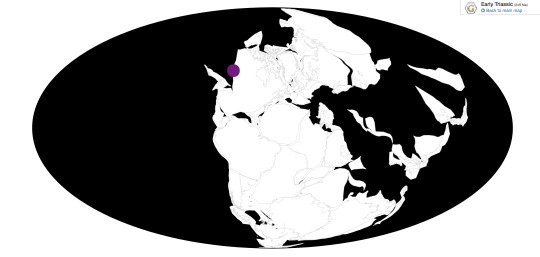
Physical Description: Rebellatrix is a coelacanth like no other. Its body is a more elongate and slender than other coelacanths, and each fin (which, being a sarcopterygian, has a fleshy “limb” for the base) has a reduced rays. But its most distinctive feature is its tail. In living coelacanths, the caudal fin forms a broad, continuous shape. It is formed from three lobes: a large upper and lower lobe, and one tiny one in the middle at the tip of the tail. In Rebellatrix, however, the upper and lower lobes have greatly expanded, projecting far posteriorly and forming pointed shapes. This gives the tail a half-moon shape, similar to tuna or some sharks. The body was covered with ridged scales and bore a complex lateral line system. The head shape is unknown, but here we’ve restored it as pikelike based on its inferred ecology.
Diet: Rebellatrix was likely an active predator; its diet likely consisted of smaller fish.
Behavior: Rebellatrix was unique among coelacanths in being a fast-moving pursuit predator; the shape of the tail fin is similar to those of fast oceanic predators today. Also uniquely, the elements of the tail fin have fused. This would have led to a less flexible tail than modern coelacanths, who are lazier “lurk-and-lunge” predators that use every fin except the tail fin for most movement. Rebellatrix, by contrast, used its tail as the basis of sustained, rapid movement, and used the other fins to fine-tune its swimming.
Ecosystem: Rebellatrix was found in the Sulphur Mountain Formation of Canada. At the time, the area was a continental shelf. Based on how rare Rebellatrix is, it is likely that it lived in the open sea and only occasionally visited the area. In fact, few other species are known from the same localities, but these include the coelacanthimorph Belemnocerca and the ichthyosaur Utatsusaurus.
Other: Rebellatrix shows that, contrary to popular belief, coelacanths were not evolutionarily stagnant for over 300 million years - there was some evolutionary innovations along the line. And, along with Saurichthys, Rebellatrix represents other fish filling the “active pursuit predator” niche that was dominated by sharks before the Permian-Triassic Extinction.
~ By Henry Thomas
Source (there’s only one so no cut)
Wendruff, A.J., Wilson, M.V.H. 2012. A fork-tailed coelacanth, Rebellatrix divaricerca, gen. et sp. nov. (Actinistia, Rebellatricidae, fam. nov.), from the Lower Triassic of western Canada. Journal of Vertebrate Paleontology 32(3): 499-511.
#rebellatrix#coelacanth#sarcopterygian#triassic#triassic madness#triassic march madness#prehistoric life#paleontology
133 notes
·
View notes
Photo

A Living Reef Fossil: New Population Of Coelacanth Discovered - https://reefs.com/2018/11/07/a-living-reef-fossil-new-population-of-coelacanth-discovered/
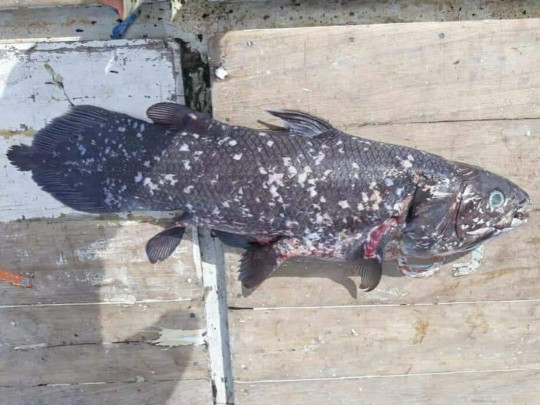
#Actinistia#coelacanth#Indonesian Coelacanth#Latimeria#Latimeria chalumnae#Latimeria menadoensis#Sarcopterygii
1 note
·
View note
Photo

I like my big, annoying forehead.
4 notes
·
View notes